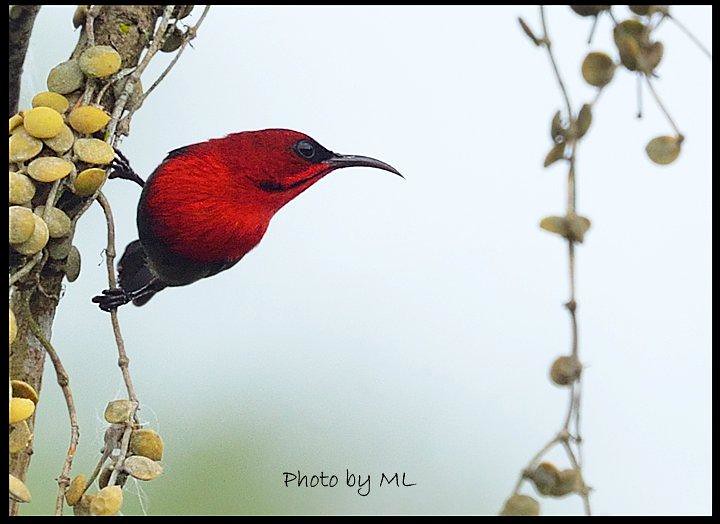
Adult male crimson sunbird, Aethopyga siparaja (protonym, Certhia Siparaja), also known as the eastern crimson sunbird, the yellow-backed sunbird, the Goulpourah sunbird, or as the scarlet-throated or scarlet-breasted sunbird, photographed in Singapore, a southeast Asian city-state off the southern tip of the Malay Peninsula.
Image: Marie-Louise Ng, 26 January 2011 (with permission) [velociraptorize].
Nikon D3s, 500/4
Question: This bird's taxonomic family was named for a life history trait possessed by the family members. Can you identify this bird's taxonomic family? Can you identify the species?
Response: This is an adult male crimson sunbird, Aethopyga siparaja. This is an Old World species that is strongly dichromatic, so adult males are unmistakable, having a crimson breast and maroon back, yellow rump and an olive-coloured belly. The female has an olive-green back, yellowish breast and white tips to the outer tail feathers.
The sunbirds are placed into the taxonomic family, Nectariniidae, which was so named because most of these birds feed on (you guessed it), nectar. Their thin downward-curving bills and brush-tipped tubular tongues are adapted specially for nectivory. Flower tubes that are shaped to prevent access to nectar are pierced at the base near the nectaries so the sunbirds can feed. Like all nectarivores, sunbirds supplement their diet with insects, particularly when rearing chicks, and some species also add fruits to the menu.
The sunbirds are the Old World equivalent to the Australian honeyeaters and to the New World hummingbirds, although they are very distant relatives (sunbirds and honeyeaters are passerines whilst hummingbirds are placed into a different order, Apodiformes). Because they have similar nectar-feeding lifestyles, sunbirds and hummingbirds in particular have converged onto several characters: they are very small-bodied; they are strongly dichromatic (with the males being brilliantly coloured), and they have the ability to enter torpor at night to save energy. Further, some sunbirds can feed whilst hovering (although they prefer to perch).
Due to their unremarkable song and demanding nature, sunbirds are not popular avicultural subjects. The crimson sunbird is the national bird of Singapore.
Here's a short video of a male crimson sunbird sitting in a tree in Thailand:
You are invited to review all of the daily mystery birds by going to their dedicated graphic index page.
If you have bird images, video or mp3 files that you'd like to share with a large and (mostly) appreciative international audience here at The Guardian, feel free to contact me to learn more.
.. .. .. .. .. .. .. .. .. .. .. ..
twitter: @GrrlScientist
facebook: grrlscientist
email: grrlscientist@gmail.com
